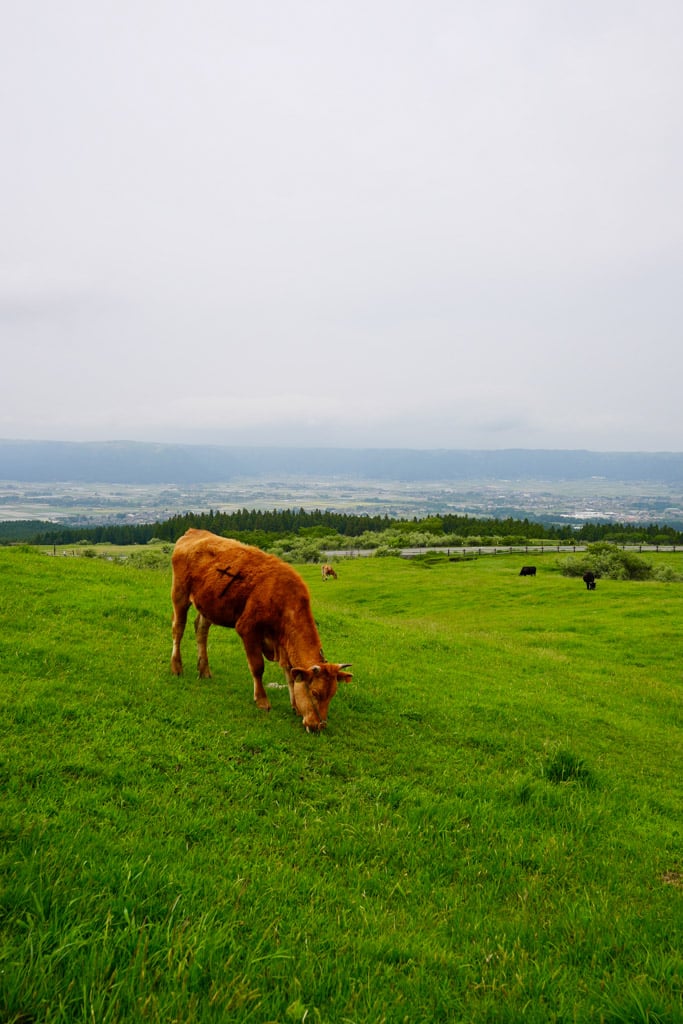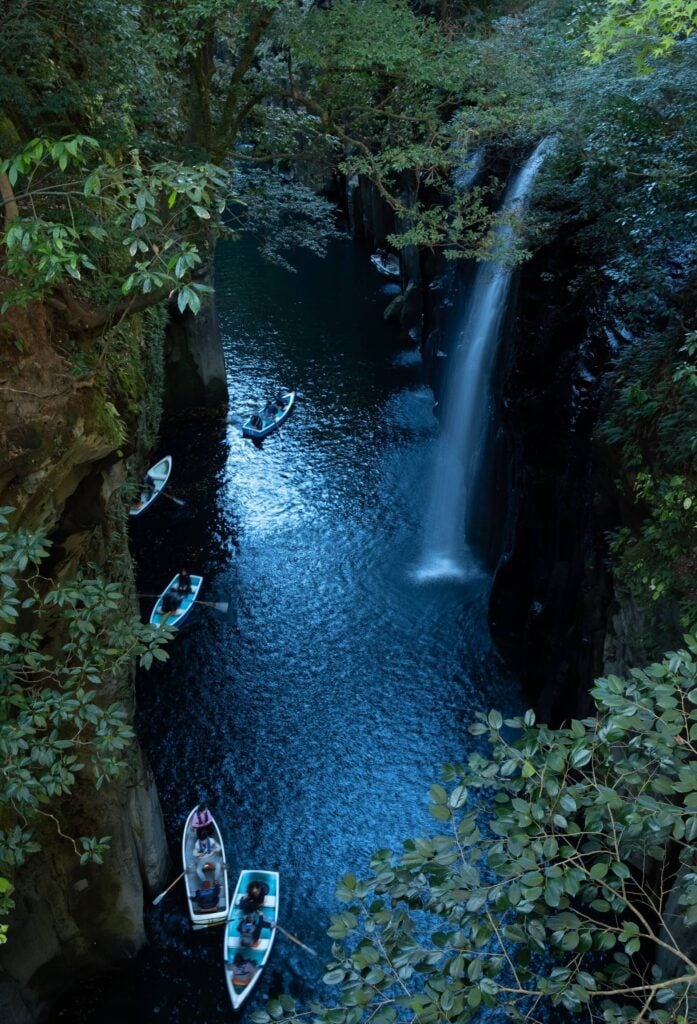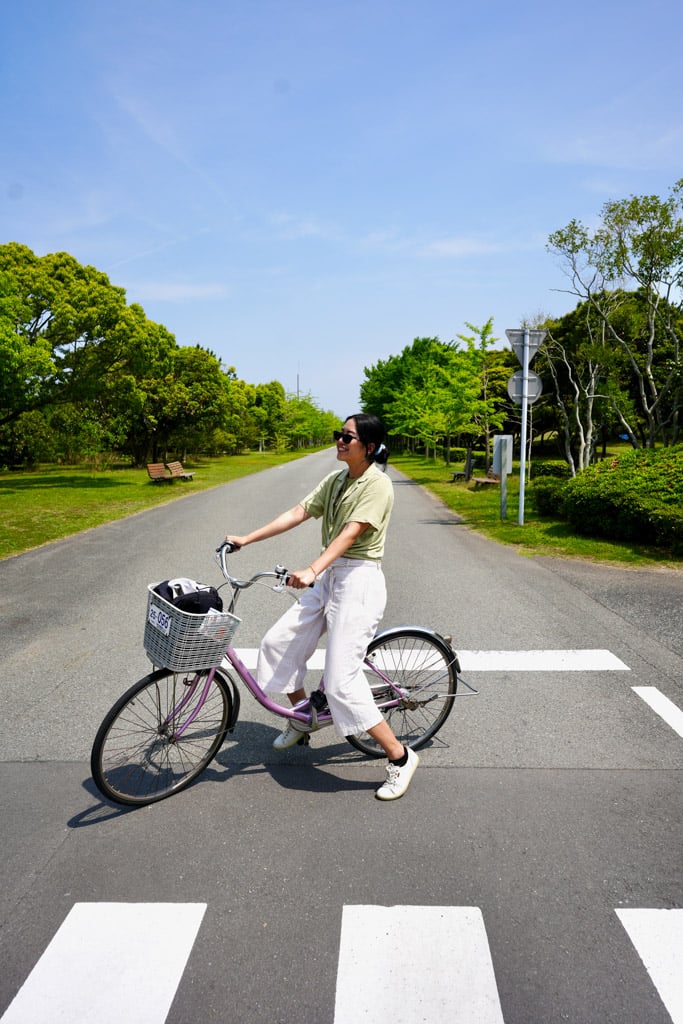Kyushu is Japan’s third-largest island, and yet hardly anyone I know has been. It’s a total shame, because the region is packed with endless greenery, steamy hot springs, terraced rice fields, and cultural gems that feel untouched by mainstream tourism.
It’s nowhere near as popular as Tokyo or Kyoto—and honestly, that’s part of the appeal. I truly appreciated the fact that we hardly encountered foreign tourists during our week-long Northern Kyushu road trip.
To be fully transparent, Kyushu isn’t for everyone. Outside of Fukuoka, a laid-back city in the north with an unparalleled food scene, the pace slows way down. Renting a car in Kyushu unleashes your exploring power tenfold.
Places like Yufuin, with its boutique ryokan and countryside views, or Kumamoto, known for its laid-back vibe and striking castle, cater more to slow travelers than bucket list box-checkers. Even Beppu and Kagoshima, with their hot springs and volcanic scenery, lean more local than flashy.
If you’re someone who appreciates peaceful landscapes, quiet traditions, and taking the time to soak it all in (literally and figuratively), Kyushu will feel like a dream.
Here are several reasons why Kyushu is worth visiting on your next trip to Japan.
This post may contain affiliate links. You won’t be paying a cent more, but in the event of a sale, the small affiliate commission I receive will help keep this blog running/pumping out useful and free content. Thanks a lot!
10 Reasons Why Kyushu Is Worth Visiting On Your Next Trip To Japan
Table of Contents
Mt. Aso

Located in Kumamoto Prefecture, Mt. Aso is one of Japan’s largest active volcanoes and sits within one of the world’s biggest calderas—spanning about 25 km across. If you’re drawn to otherworldly landscapes and wide-open spaces, the Aso area is a must.
One of my favorite memories from this region was watching the sulfuric plumes rise from Mt. Aso’s crater and enjoying the scenic trails through Aso Kuju National Park, where grassy plains, rocky ridgelines, and volcanic activity come together in one surreal setting.
A perfect day in the area usually starts with a visit to Aso’s crater, where you can take in the dramatic volcanic activity up close. From there, head down to Kusasenri for a walk across the wide, emerald green plateaus—there are no strict paths, forging your own path is encouraged!



In spring, make time to explore the lesser-visited Sensuikyo Gorge, where you’ll find a sea of pink azaleas blanketing the hillside—a local favorite that often flies under the radar. After all that wandering, kick back at your hotel and soak in a hot spring bath to wash off the day and let everything sink in.
Food-wise, the Aso area doesn’t mess around. The local Akaushi beef is some of the most tender and flavorful I’ve ever had, especially when served simply to let the quality shine. I also loved sampling all kinds of snacks and sweets made with fresh Aso milk—rich, creamy, and used in everything from soft serve to almond custards.
Where To Stay Near Mt. Aso
Kamenoi Hotel Aso – we stayed at this 4-star resort and had the most amazing/relaxing time! Half-board hotel, which means dinner and breakfast buffets are included. The food, the views, and the free activities were ALL so memorable!
Beppu Onsen

Beppu is Oita Prefecture’s premier tourist destination. This hot spring-heavy city is known for having the highest volume of hot spring water in Japan, with over 2,000 onsen sources across eight distinct hot spring areas.
It’s a fantastic place to dive into Japanese bathing culture—whether you’re into traditional indoor baths, open-air rotenburo, or quirky experiences like sand or steam baths.
We based ourselves in Beppu while exploring the greater Oita area, and to be honest, the city caught us off guard. We expected a quiet, sleepy onsen town, but what we got was way more urban—think neon signs, chain restaurants, and city sprawl.
That said, once you settle in and shift your mindset, there’s a lot to enjoy here, especially if you’re a hot spring enthusiast.
But the thing that really impressed us? The Hells of Beppu—a series of hot springs so hot they’re purely for viewing, not bathing. Each of the “hells” (jigoku) is distinctly different from the next, especially the rusty-red waters of Chinoike Jigoku and the cobalt blue ponds of Umi Jigoku!



Beyond the hot springs, Beppu has plenty to offer if you want to mix in a bit of nature and wildlife. You can ride the ropeway up Mt. Tsurumi for sweeping views of the city and coast, or head to Takasakiyama Monkey Park to see wild macaques doing their thing in the forest.
If you’ve got a car, day trips to nearby beaches, waterfalls, or even the more serene hot spring towns like Yufuin are easy to add to your itinerary.
Things To Do In Beppu
- Tour the Hells of Beppu
- Try hell-steamed food – cooked in the Jigoku Mushi way (using the steam of a hot spring to cook)
- Take a sand bath at Beppu Beach
- Visit Mount Tsurumi by ropeway and go hiking
- Spend a day at Kijima Kogen Park amusement park
- Takasaki Monkey Park – see monkeys in their natural habitat
- Umitamago Aquarium – an attractive aquarium next to the monkey park
- Take day trips to Yufuin, Kunisaki Peninsula, or Usuki
Where To Stay In Beppu
- Kannawaen ($$ – $$$)
- Amane Resort Seikai ($$ – $$$)
- Amane Resort Gahama ($$$)
Yufuin Onsen

Yufuin Onsen is a personal favorite of mine—and what’s wild is that it feels worlds away from Beppu, even though it’s only about a 30-minute drive.
While Beppu buzzes with city energy, steam towers, and concrete, Yufuin greets you with narrow roads flanked by trees, wooden storefronts, and hidden ryokans whose entrances are often tucked behind leafy canopies. It’s peaceful, romantic, and the kind of place where you’ll lose track of time.
That said, tourism has definitely found Yufuin. Around 10 or 11 a.m., the day-trippers and tour buses start rolling in, crowding the main pedestrian streets. But even with the uptick in foot traffic, the town holds onto its charm.
There’s something totally whimsical about the place. You’ll find entire shops dedicated to Ghibli merchandise, Alice in Wonderland Cheshire cat decor hanging outside of storefronts, a Snoopy-themed village, a retro car museum, chances to see owls, and plenty of quirky cafés and craft shops that make you feel like you’ve stepped into a fantasy movie.
And then there’s Mt. Yufu towering quietly in the background, grounding it all in natural beauty.



Things To Do In Yufuin
- Stroll along Yunotsubo Street, the main shopping street
- Visit the Comico Art Museum
- Get your souvenir shopping done at Snoopy Village Tea House or Donguri no Mori (for Ghibli lovers)
- Enjoy Kinrin Lake, one of the few lakes in Japan where hot springs flow out from
- Visit Yufuin Floral Village, a themed area based on the Cotswolds area of England
- Try local foods such as Bungo Beef, croquettes, and Swiss rolls
Where To Stay In Yufuin
- Hotarunoyado Sendou ($$)
- Yufudake Ichibo no Yado Kirara ($$)
- Ikkoten ($$$)
Experience a unique culture blend in Nagasaki

Head to Nagasaki and experience the place where Japanese, Chinese, and Dutch cultures meet. Sounds like a crazy combination of cultures, right?
Because of its seaside location, the ocean and ports have long played a critical role in the economic foundations and cultural development of the area.
During the period spanning from the 1600s to the mid-1800s, Nagasaki was the sole location in Japan that maintained direct contact with European nations. This distinctive past has had a huge impact on what Nagasaki looks, feels, and tastes like!
As you stroll through the city streets, you’ll sense a strong presence of both Chinese and Dutch cultures despite being in a Japanese city.
Just a brief five-minute walk from Dejima, you’ll encounter Nagasaki Chinatown, where you must try the Nagasaki champon, an exceptional soup and noodle dish teeming with a variety of ingredients and inspired by Chinese ramen. This dish has since become a symbol of the region’s local cuisine!
Nagasaki Chinatown offers a great opportunity to shop for souvenirs and enjoy an extensive range of street food, such as mahua dough twists, mooncakes, and other classic Chinese snacks.
If you happen to be a foodie, you can’t miss Shippoku cuisine, family-style dishes served on a round table. This renowned Nagasaki dining experience represents one of the area’s finest examples of blending Japanese, Chinese, and Dutch cultures.
Takachiho Gorge

Takachiho is a small town in Miyazaki Prefecture that is steeped in mythology and is considered one of the most spiritual places in Japan.
The area is most famously home to the Takachiho Gorge, a beautiful natural gorge known for its crystal-clear mountain waters that are said to have been formed by the god Susanoo.
Takachiho-kyo is truly a sight to see because its cliffs, chock-full of twisted stones, look like the scales of a dragon. Visitors can take a boat ride through the gorge and see the waterfall that is said to be the home of the god’s wife.
Once your boat tour ends, the cultural immersion doesn’t stop. Other notable things to do here include catching one of the Kagura dance performances at Takachiho Shrine, where locals perform an abridged version of the Yokagura every night at 8 p.m. This costs about 1,000 yen per person and reservations can be made online.
From there, you can also visit Amano Iwato-jinja Shrine, an ancient shrine inside a cave.
Because Takachiho is not the easiest place to get to, the best way to visit this area is by car or by sightseeing bus. Full-day combo tours featuring Takachiho Gorge usually depart from Kumamoto and Fukuoka.
Kawachi Fuji-en Gardens (Kitakyushu)

If you’re planning to be in Kyushu during spring, make sure Kawachi Fuji-en Garden in Kitakyushu is on your radar. This place is home to one of the most jaw-dropping seasonal experiences in all of Japan: walking through massive wisteria tunnels in full bloom.
The garden opens for only a few weeks each year—usually from mid-April to early May—and the timing can shift slightly depending on the weather that year.
What makes it so special? The centerpiece is two tunnels—one about 80 meters long and another closer to 100—where wisteria in all shades of purple, white, and soft pink hang down in dense clusters overhead, creating a dreamy, flower-drenched canopy. The scent alone is worth the trip, especially in the early morning when the air is still cool and the petals are dewy.
Outside of the tunnels, the garden is filled with wisteria trellises, curved walking paths, and views of the surrounding hills. It’s an especially peaceful experience if you can visit early in the day before the crowds arrive!
The food scene in Fukuoka

Fukuoka is hands-down one of Japan’s best food cities—especially if you’re into bold, savory flavors and late-night street eats.
This is the birthplace of Hakata ramen, known locally and proudly for its creamy, pork-bone-based (tonkotsu) broth, super thin noodles, and intensely savory depth. You’ll find ramen shops all over the city, but a steaming bowl enjoyed elbow-to-elbow at one of the city’s yatai (open-air food stalls) is a must-do, especially after dark.
These yatai are a core part of Fukuoka’s food culture and a big reason why this city stands out from others in Japan. Scattered mostly along the river and in neighborhoods like Nakasu and Tenjin, they offer everything from ramen and yakitori to regional dishes like motsunabe (a hot pot made with beef or pork offal).
It’s an atmosphere that’s casual, friendly, warm, and very, very local.
Fukuoka also happens to be the capital of mentaiko—spicy cod roe. You’ll find it tucked into rice balls, slathered over pasta, stuffed in omelets, and topping sushi. If you’re not usually a roe person, Fukuoka might just convert you.




Outside of the food scene, Fukuoka still holds its own. You can take a peaceful half-day trip out to Dazaifu Tenmangu Shrine, especially magical during plum blossom season in late winter to early spring.
For some physical activity out under the sun, I personally love spending the day biking around Uminokamichi Seaside Park and seeing the capybaras while I’m there!
If you’re up for a mini road trip, Itoshima’s beachy coastline offers a laid-back vibe with seaside cafés, beach swings, and an unexpected surfer scene.
Pro Tip: For a ramen pilgrimage, swing by Canal City’s Ramen Stadium to try multiple regional styles in one place.
Sakurajima and Kagoshima

If you’re still riding the high of dramatic landscapes, make sure to swing down to Kagoshima, where Sakurajima looms large.
This constantly rumbling giant is one of Japan’s most active volcanoes and sits just a short ferry ride from the city. When conditions allow, you can hop over to the island for a closer look via hiking trails or observation points, with ash plumes often adding an eerie, cinematic quality to the sky.
But Kagoshima isn’t just about lava and ash. The city itself has plenty to offer: soak in an onsen with a view of Sakurajima, stroll through Sengan-en Garden (a former samurai estate with super pretty views), or learn more about the region’s history at the Shoko Shuseikan Museum, which tells the story of industrial Japan’s early days.
Food-wise, this is where you can try Kurobuta (black pork)—a Kagoshima specialty that’s incredibly tender—and fresh seafood from nearby waters.
If you’ve got time, add Yakushima Island to your itinerary. Just a few hours by ferry, this UNESCO World Heritage Site is home to ancient cedar forests, moss-covered trails, and wildlife like macaques and deer. A day here feels like stepping into another world entirely.
Surfing In Miyazaki
Miyazaki is a prefecture located on the eastern coast of Kyushu and is known for its world-class surfing spots. The area’s warm waters and consistent waves attract surfers from around the world.
Some of the best spots include Aoshima Beach, Kisakihama Beach, and Shirahama Beach. Even if you’re not a surfer, the beautiful beaches and laid-back atmosphere make Miyazaki a great destination for a relaxing vacation.
Saga’s Pottery Towns
Saga Prefecture is a must for travelers interested in Japan’s pottery traditions, with three standout towns—Arita, Imari, and Karatsu—each known for its own distinct ceramic style.
Arita is considered the birthplace of Japanese porcelain and is a great place to start your visit. You can explore Arita Sera, a complex of pottery shops showcasing everything from classic blue-and-white porcelain to more modern interpretations. For a broader view, the Arita Porcelain Park offers historical context and a quirky replica of a European palace.
About 30 minutes away, Imari’s Okawachiyama village is a highlight—it’s a former “secret kiln” town with narrow lanes, tiled walls, and a peaceful, tucked-away atmosphere that feels straight out of a Ghibli film. This is where you’ll find Nabeshima ware, a refined, colorful porcelain once reserved for nobility. Many shops here offer paint-your-own pottery experiences if you want a personalized souvenir.
If you have extra time, head to Karatsu, known for its rustic, earthy pottery used in tea ceremonies and everyday wares. Along the way, grab lunch featuring Imari beef or local soba served in handmade ceramic bowls.
It’s an easy half-day trip from Fukuoka or even Beppu if you have a car!
Do You Need A Car To Explore Kyushu?
Technically, no—you can get around Kyushu by train, as long as the places you’re visiting are serviced by rail. But after 6–7 trips to Japan, we’ve learned that lugging your suitcase on and off multiple trains on a daily basis is a total pain in the ass gets old real fast. LOL.
Renting a car not only gives you way more flexibility, but also opens up a more authentic travel experience—you’ll get to visit local bakeries and restaurants outside of the main city centers, and reach further away attractions without having to book extra bus tours.
Honestly, after unlocking that freedom with a rental car in Kyushu, we’d do it again in a heartbeat.
We rented a car through Toyota Rent-A-Car, but other popular local options include Nippon Rent-A-Car and Nissan Rent-A-Car. When we were in Japan, we saw these three brands at nearly all the major airports.
You can compare prices between the major brands using Klook’s car rental search.
👉 Pro Tip: When renting a car, choose the option that includes ETC, the automated toll system that allows you to drive directly past toll gates in the ETC lanes. Once you return your car, you’ll pay all the toll fees you’ve accumulated on your trip. This means no fumbling with coins while driving!
Planning Your Trip To Japan?
Here are a few other useful travel guides to help you plan the perfect trip to Japan.
Kyushu Region
- Fukuoka 101: 15 Things That Make Japan’s Coolest City Worth Visiting
- Kurokawa Onsen: Your Guide To Japan’s Most Scenic Hot Spring Town
- How To Spend A Perfect Day At Yufuin Onsen, Japan
- 15 Unmissable Things To Do In Beppu For First-Timers
- 7 Best Ryokans In Beppu, Japan (With Private Onsen)
- 10 Amazing Onsen Towns In Japan To Visit On Your Next Trip
More Japan Travel Tips
- Japan On A Budget: 45 Ultimate Tips For An Affordable Vacation
- 30 Unique Activities To Add To Your Kyoto Bucketlist
- 20 Unique Things To Do In Osaka (Other Than Castles + Shrines)
- 15+ Best Theme Parks Near Tokyo, Japan
- 10 Effortless Day Trips From Tokyo For Your Japan Itinerary
- A Perfect Day Trip Itinerary For Kawagoe, Japan (From Tokyo)
